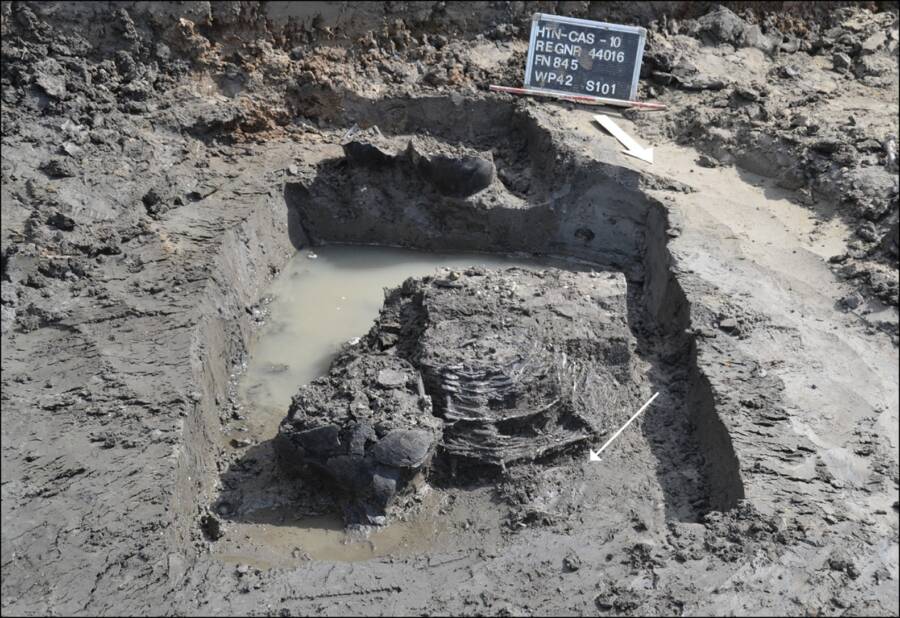Black henbane can be used medicinally or to cause visual hallucinations, and the bone container is the first evidence that ancient people deliberately collected and used the plant.

Antiquity JournalAncient physicians noted that black henbane could be used as a sedative and analgesic.
Archaeologists have long found evidence of the plant black henbane (Hyoscyamus niger) at ancient sites. The plant, a weed, can be used medicinally or to cause visual hallucinations.
Now, the discovery of a hollowed-out bone containing black henbane seeds seems to suggest that ancient Romans deliberately collected and used this plant, which could cause “insanity and giddiness.”
Discovering The Bone Container In The Netherlands
While excavating a muddy pit at an ancient Roman settlement in Houten-Castellum, the Netherlands, archaeologists found a carved-out animal femur, likely from a goat or a sheep. The bone vial, which dated to around 70 and 100 C.E., was about 2.8 inches long and packed with black henbane seeds.
Tellingly, the bone was also sealed with a piece of black birch bark used as a plug. This suggests — for the first time — that black henbane seeds were deliberately used by ancient people.

Antiquity JournalThe muddy pit where the bone was found. Archaeologists were able to date the item based on ceramics and a wire brooch found at the same time.
“Since the plant can grow naturally in and around settlements, its seeds can end up in archaeological sites naturally, without intervention by humans,” Maaike Groot, the lead author of a new study about the discovery and a zooarchaeologist at the Free University of Berlin, said in a statement.
Indeed, black henbane seeds — the plant is also known as stinking nightshade — have been documented at ancient sites across Europe dating as far back as 5500 B.C.E. Because black henbane is a weed, it’s been difficult for researchers to determine whether the seeds were cultivated and used by ancient humans or if they arrived at archaeological sites naturally.
But the bone container seems to settle that debate.
“This find proves beyond doubt that people were actually collecting and using black henbane seeds, something that cannot be proven purely by the presence of the seeds in an archaeological site,” Groot told All That’s Interesting in an email. Previously, she added, it’s been “tricky” to distinguish between what ancient people grew on purpose and what grew naturally.
So what did ancient Romans use the seeds for?
How Ancient Romans Used Black Henbane
Though black henbane is a highly poisonous plant, it has both medicinal and psychoactive properties. Ancient people were well aware of this.
As Heritage Daily reports, the Greek physician and botanist Pedanius Dioscorides described it as a sedative and analgesic. Meanwhile, the Roman author Pliny the Elder declared that black henbane was “of the nature of wine and therefore offensive to the understanding.” He added that the seeds could induce “insanity and giddiness.”

Mikenorton/Wikimedia CommonsFlowering black henbane.
But though the plant’s properties were documented in antiquity, it’s long been unclear how ancient people used black henbane.
“Even the fact that Classical authors knew about the effects of the plant says little about whether it was actually used,” Groot remarked to All That’s Interesting.
The discovery of the bone container, packed with seeds and carefully sealed, strongly suggests that ancient people did use the seeds. But to what purpose? Were ancient Romans in Houten-Castellum using black henbane to induce visual hallucinations, or as a medicine to reduce pain?
For now, that’s still a tantalizing question.
“I personally believe the seeds were used medicinally, for example as a painkiller,” Groot told All That’s Interesting, “but we cannot exclude that they were used for their hallucinatory effect.”
After reading about the black henbane seeds found in a sealed bone at an ancient Roman site in the Netherlands, look through these surprising facts about life in ancient Rome. Or, discover the origin of the term “Crossing the Rubicon.”





